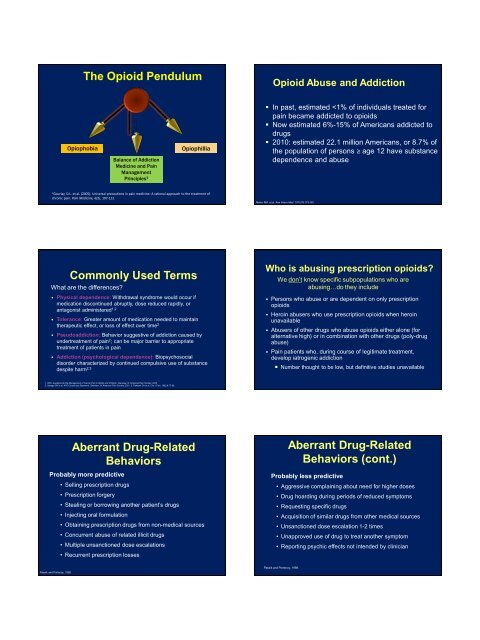Taking Control: Emerging Issues in Pain ... - Pharmacy Times
Taking Control: Emerging Issues in Pain ... - Pharmacy Times
Taking Control: Emerging Issues in Pain ... - Pharmacy Times
Create successful ePaper yourself
Turn your PDF publications into a flip-book with our unique Google optimized e-Paper software.
The Opioid Pendulum<br />
Opioid Abuse and Addiction<br />
Opiophobia<br />
Balance of Addiction<br />
Medic<strong>in</strong>e and Pa<strong>in</strong><br />
Management<br />
Pr<strong>in</strong>ciples 1<br />
Opiophillia<br />
• In past, estimated ˂1% of <strong>in</strong>dividuals treated for<br />
pa<strong>in</strong> became addicted to opioids<br />
• Now estimated 6%-15% of Americans addicted to<br />
drugs<br />
• 2010: estimated 22.1 million Americans, or 8.7% of<br />
the population of persons ≥ age 12 have substance<br />
dependence and abuse<br />
1 Gourlay, D.L. et al. (2005). Universal precautions <strong>in</strong> pa<strong>in</strong> medic<strong>in</strong>e: A rational approach to the treatment of<br />
chronic pa<strong>in</strong>. Pa<strong>in</strong> Medic<strong>in</strong>e, 6(2), 107-112.<br />
Marks RM, et al. Ann Intern Med. 1973;78:173-181.<br />
Commonly Used Terms<br />
What are the differences<br />
• Physical dependence: Withdrawal syndrome would occur if<br />
medication discont<strong>in</strong>ued abruptly, dose reduced rapidly, or<br />
antagonist adm<strong>in</strong>istered 1,2<br />
• Tolerance: Greater amount of medication needed to ma<strong>in</strong>ta<strong>in</strong><br />
therapeutic effect, or loss of effect over time 2<br />
• Pseudoaddiction: Behavior suggestive of addiction caused by<br />
undertreatment of pa<strong>in</strong> 2 ; can be major barrier to appropriate<br />
treatment of patients <strong>in</strong> pa<strong>in</strong><br />
• Addiction (psychological dependence): Biopsychosocial<br />
disorder characterized by cont<strong>in</strong>ued compulsive use of substance<br />
despite harm 2,3<br />
Who is abus<strong>in</strong>g prescription opioids<br />
We don’t know specific subpopulations who are<br />
abus<strong>in</strong>g…do they <strong>in</strong>clude<br />
• Persons who abuse or are dependent on only prescription<br />
opioids<br />
• Hero<strong>in</strong> abusers who use prescription opioids when hero<strong>in</strong><br />
unavailable<br />
• Abusers of other drugs who abuse opioids either alone (for<br />
alternative high) or <strong>in</strong> comb<strong>in</strong>ation with other drugs (poly-drug<br />
abuse)<br />
• Pa<strong>in</strong> patients who, dur<strong>in</strong>g course of legitimate treatment,<br />
develop iatrogenic addiction<br />
• Number thought to be low, but def<strong>in</strong>itive studies unavailable<br />
1. APS. Guidel<strong>in</strong>e for the Management of Cancer Pa<strong>in</strong> <strong>in</strong> Adults and Children. Glenview, Ill: American Pa<strong>in</strong> Society; 2005.<br />
2. Savage SR et al. APS Consensus Statement. Glenview, Ill: American Pa<strong>in</strong> Society; 2001. 3. Fishba<strong>in</strong> DA et al. Cl<strong>in</strong> J Pa<strong>in</strong>. 1992;8:77-85.<br />
Aberrant Drug-Related<br />
Behaviors<br />
Probably more predictive<br />
• Sell<strong>in</strong>g prescription drugs<br />
• Prescription forgery<br />
• Steal<strong>in</strong>g or borrow<strong>in</strong>g another patient’s drugs<br />
• Inject<strong>in</strong>g oral formulation<br />
• Obta<strong>in</strong><strong>in</strong>g prescription drugs from non-medical sources<br />
• Concurrent abuse of related illicit drugs<br />
• Multiple unsanctioned dose escalations<br />
• Recurrent prescription losses<br />
Aberrant Drug-Related<br />
Behaviors (cont.)<br />
Probably less predictive<br />
• Aggressive compla<strong>in</strong><strong>in</strong>g about need for higher doses<br />
• Drug hoard<strong>in</strong>g dur<strong>in</strong>g periods of reduced symptoms<br />
• Request<strong>in</strong>g specific drugs<br />
• Acquisition of similar drugs from other medical sources<br />
• Unsanctioned dose escalation 1-2 times<br />
• Unapproved use of drug to treat another symptom<br />
• Report<strong>in</strong>g psychic effects not <strong>in</strong>tended by cl<strong>in</strong>ician<br />
Passik and Portenoy, 1998.<br />
Passik and Portenoy, 1998.



